Key Takeaway: New private passenger services like Uber, Lyft and Autonomous Vehicles should be accessible to all users. Despite not having regulatory authority over these services, the SFMTA can continue to participate in rulemaking processes to ensure that the needs of disabled riders are being met.
Private Passenger Services and Accessibility
Transportation Network Companies, such as Uber and Lyft, and autonomous vehicle (AV) passenger services, like Waymo, Cruise and Zoox, are private passenger services that must be reserved in advance, either through a smartphone app or a phone call. Unlike taxi cabs, TNC and AV passenger services cannot be hailed on the street or at a taxi stand.
TNCs and AV passenger services have provided an unprecedented level of access to on-demand transportation for people with visual disabilities; employment for deaf and hard of hearing individuals as drivers; and more timely access to healthcare for some riders who do not require wheelchair accessible service.
On the other hand, many of the benefits that have attracted users to TNCs, such as quick response time, cheaper fares and ease of payment, have not been afforded equally to all riders with disabilities. Wheelchair users who require accessible vehicles have largely been unable to use the services and have experienced a corresponding decline in availability of on-demand accessible services they previously relied upon.
While TNCs like Uber and Lyft have made some progress in providing on-demand wheelchair accessible service to the public, the AV companies operating in California have not deployed autonomous wheelchair accessible vehicles. Waymo currently provides non-autonomous WAV service to select passengers with disabilities in standard accessible vehicles with drivers.
Regulation of Private Passenger Services
The SFMTA does not have regulatory authority over TNCs or AV passenger services, like Waymo, Zoox, and Cruise. This responsibility is held by state and federal agencies, including the California Public Utilities Commission (CPUC), the California Department of Motor Vehicles (DMV), and the National Highway Traffic Safety Administration (NHTSA).
The SFMTA has submitted numerous policy comments in state and federal rulemaking advocating for increased safety and accessibility. We have worked closely with the San Francisco County Transportation Authority and the San Francisco Mayor’s Office on Disability to develop proposals and comment on proceedings. The SFMTA has also coordinated with disability advocates from Disability Rights California, the Disability Rights Education and Defense Fund (DREDF), and the Center for Accessible Technology to ensure that the voices of disabled riders are heard in the rulemaking process.
Policy outcomes have been mixed. In 2018, the TNC Access for All Act was signed into law by Senate Bill 1376. The bill requires the CPUC to develop regulations relating to accessibility for persons with disabilities, including wheelchair users who need a wheelchair-accessible vehicle (WAV). The goal of the bill is to expand and improve on-demand WAV transportation in California. Similar legislation and rulemaking has not been required of AV passenger services.
Transportation Network Company Wheelchair Accessible Service Data
The City of San Francisco has also prioritized TNC WAV data transparency, working with ZS Associates through the Civic Bridge program to create performance dashboards.
These dashboards visualize data submitted to the CPUC by TNCs. The data show that San Francisco TNC WAV ridership is lower than it was pre-pandemic, but rides have been trending upward over the past few years. Reported response times have been steady, with Uber’s response time averaging 18.31 minutes in Quarter 3 of 2022, and Lyft averaging 15.23 minutes in the same period.
Uber is serving more WAV trips than Lyft in San Francisco, with 1,559 trips completed out of 2,344 requested in Q3 2022 at Uber, compared to 270 trips completed out of 295 requested at Lyft. In other words, Uber served 85% of completed WAV trips.
In exchange for providing a certain level of service, a TNC may apply for offsets and exemptions which allow a TNC to keep a portion of the 10 cent rider fees they collect as mandated by the TNC Access for All Act. While San Francisco tracks the data that the TNCs submit, the CPUC has not previously required TNCs to share trip data for quarters where they do not apply for an offset or exemption.
A recent decision changed this rule and going forward TNCs will be required to submit trip data regardless of whether they apply for an offset or exemption. However, gaps exist in the current data. For example, Uber did not submit trip data for San Francisco in Q4 2022 or Q1 2023, making it more challenging to discern ridership patterns.
Figure 1. WAV Trips Requested and Completed in San Francisco
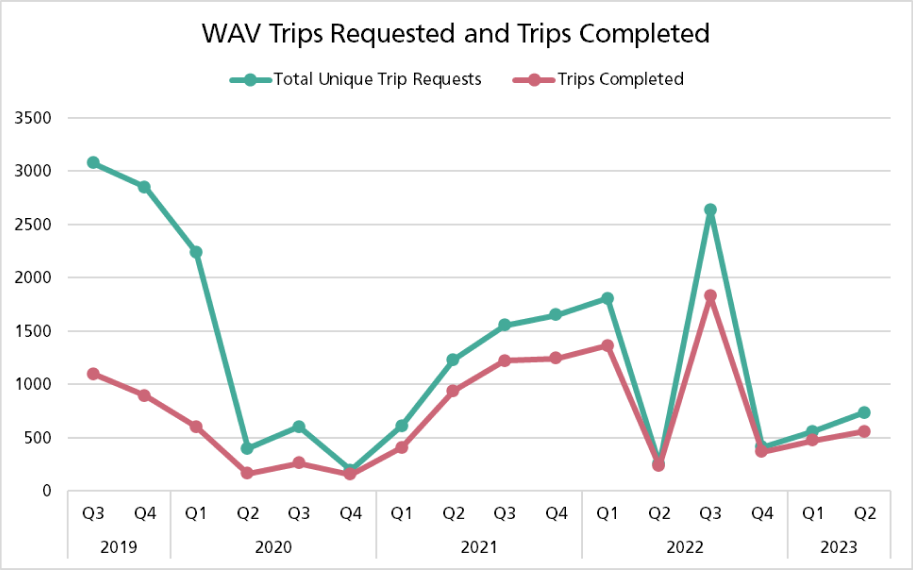
Figure 2. WAV Trips Requested and Completed by Uber
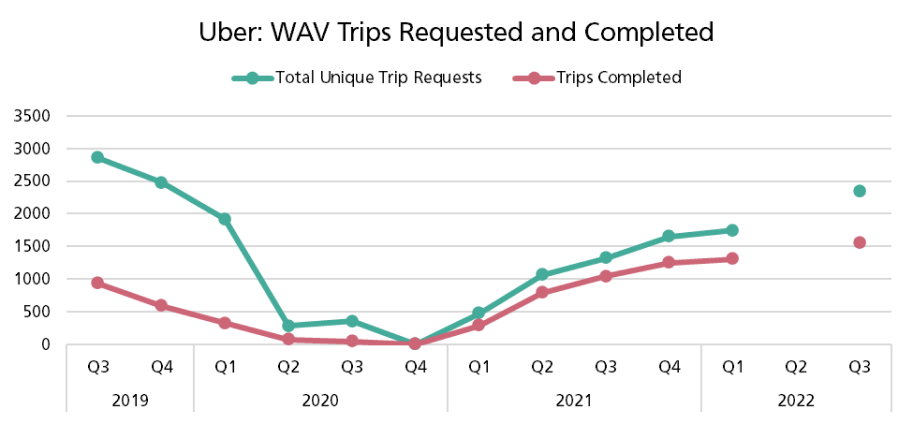
Figure 3. WAV Trips Requested and Completed by Lyft
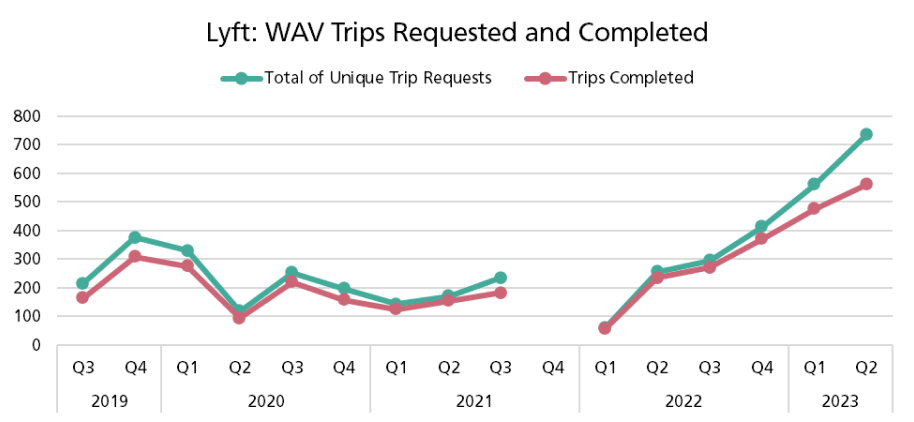
Figure 4. WAV Response Times for Uber
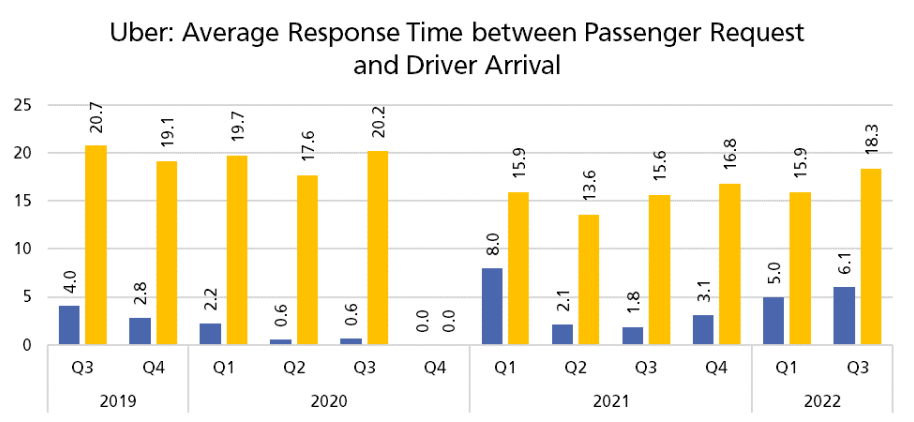

Figure 5. WAV Response Times for Lyft
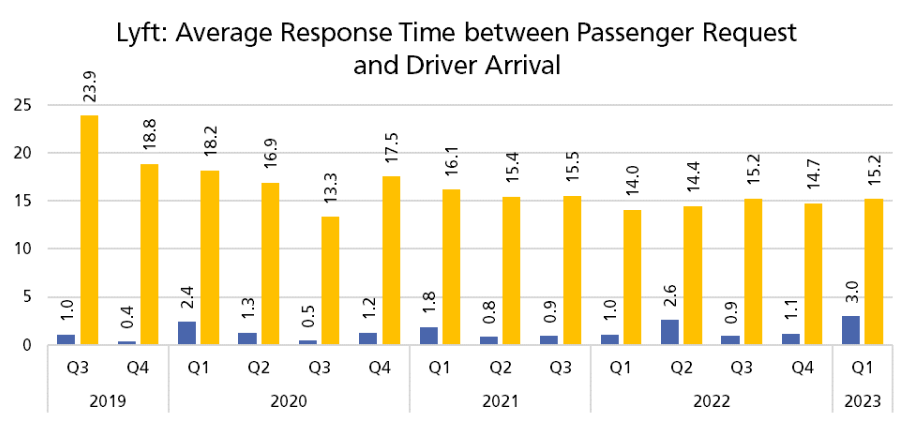

Improving the Accessibility of Private Passenger Services in San Francisco
The TNC Access for All Act created a financial incentive for TNCs to increase accessibility by imposing a $0.10 per-trip fee on all TNC rides in the state. The funds from this fee are then used to reimburse ride-hailing companies for their expenses if they demonstrate they are improving access to WAVs on their platforms. Any remaining funds not claimed by TNCs are set aside by the CPUC in a fund called the Access Fund.
In July 2021, the CPUC designated the SFMTA as the Local Access Funds Administrator. These funds are distributed to Access Providers, which are transportation carriers that directly provide on-demand WAV service or contract with another entity to provide this service. Every year, the SFMTA will receive new funding from the Access Fund. This will begin in funding year 2023-2024. We are in the process of selecting Access Providers that will be awarded Access for All funds. An RFP for Access Providers was issued on March 14, 2024.